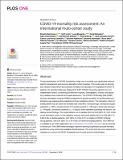| dc.contributor.author | Bertsimas, Dimitris J | |
| dc.contributor.author | Lukin, Galit | |
| dc.contributor.author | Mingardi, Luca | |
| dc.contributor.author | Nohadani, Omid | |
| dc.contributor.author | Orfanoudaki, Agni | |
| dc.contributor.author | Stellato, Bartolomeo | |
| dc.contributor.author | Wiberg, Holly | |
| dc.contributor.author | Gonzalez-Garcia, Sara | |
| dc.contributor.author | Parra-Calderón, Carlos Luis | |
| dc.contributor.author | Robinson, Kenneth | |
| dc.contributor.author | Schneider, Michelle | |
| dc.contributor.author | Stein, Barry | |
| dc.contributor.author | Estirado, Alberto | |
| dc.contributor.author | a Beccara, Lia | |
| dc.contributor.author | Canino, Rosario | |
| dc.contributor.author | Dal Bello, Martina | |
| dc.contributor.author | Pezzetti, Federica | |
| dc.contributor.author | Pan, Angelo | |
| dc.contributor.author | Hellenic COVID-19 Study Group | |
| dc.date.accessioned | 2020-12-11T19:05:36Z | |
| dc.date.available | 2020-12-11T19:05:36Z | |
| dc.date.issued | 2020-12 | |
| dc.date.submitted | 2020-07 | |
| dc.identifier.issn | 1932-6203 | |
| dc.identifier.uri | https://hdl.handle.net/1721.1/128817 | |
| dc.description.abstract | Timely identification of COVID-19 patients at high risk of mortality can significantly improve patient management and resource allocation within hospitals. This study seeks to develop and validate a data-driven personalized mortality risk calculator for hospitalized COVID-19 patients. De-identified data was obtained for 3,927 COVID-19 positive patients from six independent centers, comprising 33 different hospitals. Demographic, clinical, and laboratory variables were collected at hospital admission. The COVID-19 Mortality Risk (CMR) tool was developed using the XGBoost algorithm to predict mortality. Its discrimination performance was subsequently evaluated on three validation cohorts. The derivation cohort of 3,062 patients has an observed mortality rate of 26.84%. Increased age, decreased oxygen saturation (≤ 93%), elevated levels of C-reactive protein (≥ 130 mg/L), blood urea nitrogen (≥ 18 mg/dL), and blood creatinine (≥ 1.2 mg/dL) were identified as primary risk factors, validating clinical findings. The model obtains out-of-sample AUCs of 0.90 (95% CI, 0.87–0.94) on the derivation cohort. In the validation cohorts, the model obtains AUCs of 0.92 (95% CI, 0.88–0.95) on Seville patients, 0.87 (95% CI, 0.84–0.91) on Hellenic COVID-19 Study Group patients, and 0.81 (95% CI, 0.76–0.85) on Hartford Hospital patients. The CMR tool is available as an online application at https:/www.covidanalytics.io/mortality_calculator and is currently in clinical use. The CMR model leverages machine learning to generate accurate mortality predictions using commonly available clinical features. This is the first risk score trained and validated on a cohort of COVID-19 patients from Europe and the United States. | en_US |
| dc.publisher | Public Library of Science (PLoS) | en_US |
| dc.relation.isversionof | https://doi.org/10.1371/journal.pone.0243262 | en_US |
| dc.rights | Creative Commons Attribution 4.0 International license | en_US |
| dc.rights.uri | https://creativecommons.org/licenses/by/4.0/ | en_US |
| dc.source | PLoS | en_US |
| dc.title | COVID-19 mortality risk assessment: An international multi-center study | en_US |
| dc.type | Article | en_US |
| dc.identifier.citation | Bertsimas, Dimitris et al. "COVID-19 mortality risk assessment: An international multi-center study." PLoS One 15, 12: e0243262 © 2020 Bertsimas et al. | en_US |
| dc.contributor.department | Sloan School of Management | en_US |
| dc.relation.journal | PLoS One | en_US |
| dc.eprint.version | Final published version | en_US |
| dc.type.uri | http://purl.org/eprint/type/JournalArticle | en_US |
| eprint.status | http://purl.org/eprint/status/PeerReviewed | en_US |
| dspace.date.submission | 2020-12-11T16:25:38Z | |
| mit.journal.volume | 15 | en_US |
| mit.journal.issue | 12 | en_US |
| mit.license | PUBLISHER_CC | |
| mit.metadata.status | Complete | |
